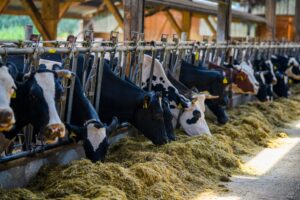Almost half of PM2.5 emissions from domestic burning come from outdoor sources, according to research commissioned by the Stove Industry Alliance.
The researchers analysed data from the Defra commissioned Kantar Survey (2020), the EEA Inventory Guidebook, industry surveys, sales data, and a range of journal articles.
The peer-reviewed study found that an estimated 46% and 51% of domestic particulate matter (PM2.5) pollution originates from outdoor burning.
According to the report, the largest single contributor to domestic outdoor burning emissions is green waste. They say this accounts for 90% of all outdoor burning emissions when combined with waste wood and rubbish.
The study also highlighted that stoves meeting Ecodesign requirements contribute just 2.7% of the emissions from indoor burning, while open fires contribute 39%.
However, Jemima Hartshorn, founder of campaign group Mums for Lungs has disputed these figures, pointing to a recent report which highlighted that most Eco-design stoves emit 300 times more PM2.5 than most modern HGV’s.
Jemima told Air Quality News: ‘Woodburning, whether indoors or outdoors is usually a lifestyle choice – but it has a huge health impact on yourself, your family, and your neighbours. As a recent study showed, the emissions from the most current Eco-design stove will emit 300 times as much particulate matter as the most modern HGV. This is terrible on young and old lungs, contributing to wheezing, asthma, and many other health issues. Really we need Government to deliver the legislation to protect us all from indoor and outdoor burning.’
Andy Hill, chair of the Stove Industry Alliance (SIA) who commissioned the research, said: ‘For far too long now the finger of blame for poor air quality has been pointed at burning wood for heat inside the home.
‘What this analysis shows is that half of the PM2.5 emissions that the Clean Air Strategy links to indoor domestic burning are coming from outdoor burning. The problem with these outdoor burning emissions is that they are almost entirely unregulated and produce no useable heat.’
‘Indoor wood burning stoves are subject to a range of regulations to ensure that emissions are minimised and efficiency is maximised. This new research shows that appliances that meet Ecodesign regulations account for a very small percentage of PM2.5 emissions, just 2.7%, whereas open fires contribute over 14 times as much. This provides clear evidence of the benefits of switching to modern Ecodesign stoves and shows that calls for all wood-burning stoves to be banned are misguided and based on flawed data.’
The research findings have been shared with all key government departments in the UK and the SIA is calling for an urgent review of the National Atmospheric Emissions Inventory quantification of domestic burning PM2.5 emissions.
In related news, late last year, Air Quality News spoke to Dr. Gary Fuller and a spokesperson from the Stove Industry Alliance to find out the truth about wood-burning stoves and air pollution.

















I really want to know now which is more polluting, gas central heating or wood stoves. I found this on the internet today: Greater London Authority Domestic Boiler Emission Testing Report November 2019. Executive Summary: ‘Domestic gas is predicted to replace transport as the largest source of NOX by 2025. Page 9. While NOX emissions from boilers are of key interest in the scope of emissions inventories, it is generally considered that there is little measurable particulate matter (PM) emission from gas boilers, accordingly there are no current or proposed regulations regarding PM emissions’. And there was this too: https://wood-energy.extension.org which says: ‘The NOx (if kept below 1300 celsius) and SOx emissions from burning wood are much lower than those of the fossil fuels coal and petroleum products, and comparable to those of natural gas. Particulate levels in wood emissions are similar to those from burning coal and petroleum and substantially higher than the levels in the emissions from natural gas’. I conclude the NOx emissions are similar from wood and domestic gas combustion? Can anyone here confirm that? But the former (wood burning) makes far more fine particulate air pollution. Presumably that depends on the stove and fuel.Better to avoid both then? But what’s the solution?
about gas central heating boilers versus wood I found this – Fireplaces: Electric vs Gas vs Wood-Burning Stoves – Which?
The SIA “Stove Industry Alliance responds to wood-burning stove and HGV comparison” article is without balance or rebuttal of unsubstantiated claims is irresponsible journalism.
The SIA are frequently active on social media and other publications and will lobby Government and media quite heavily to protect their interests and have even commissioned their own report to make these unsubstantiated or peer reviewed reports (at their cost, not independent).
This is a serious attempt by the stove industry to challenge the Government’s own data for PM2.5 regarding the contribution that comes from wood and solid fuel burning. The approach is a smoke screen which tries to muddy the water with spurious claims about bonfires, barbecues and fire pits, which are undoubtedly a serious nuisance but this by its nature will usually only be for short periods mostly in daylight and unlike burning solid fuel in the home do not go on for 9 months or more of the year for many hours at time on a majority of days, and their denial of the high (comparative to other sources) pollution from stoves is of concern as the data they seem get publicity using is often unsupported by independent peer review and their publicity is more economical with the facts making limited comparisons to other far less polluting sources such as gas or air source heat pumps (running on renewable energy).
Speaking as someone with many years personal experience of living near several homes within 250 m (and one with a chimney closer than 2 m from my home) with some form of Eco-design stove installed, I have investigated the subject thoroughly but would not really need any further understanding or research as to where the pollution comes from, and that down drafts and temperature inversions in cold weather trap the pollution at ground level making emission height irrelevant. If emission height were a factor then why does everywhere across the country stink of wood smoke at ground level during the heating season which comes from these same chimneys because down drafts and normal turbulence experienced around buildings along with temperature inversions will bring the pollution down to ground level.
The pollution comparison with HGV’s the SIA tried to exclude was an example of how much worse the pollution from a solid fuel fire is and justifiable comparison. Whilst living in a quiet residential area I don’t usually find 18 HGVs parked outside my home for 9 hours at a time as they obviously spend most of their time on Motorways, Dual Carriageways and A Roads away from residential areas and if they did I’m sure the Council would stop it, unfortunately my personal experience over 5 years is that Councils are unwilling to do anything to stop residential wood stove pollution.
Previous challenges to the SIA regarding comparisons with HGV’s are actually not unfair as they are heavily regulated, emission controlled, subject to regular MOT’s and spot checks (as are all transport ICE vehicles) whilst solid fuel stoves are a static device installed where their emissions based on flawed (recently published US and Australian studies) where lab based checks were shown as flawed. Also, once installed stoves are mostly unregulated or independently controlled with the person operating them effectively free to use whatever fuel they choose, and they can even adjust the amount of air (throttled or chocked) passing over the fuel which changes/increases the amount of pollution produced making pollution worse. Stoves, when lit, emit 100% of their emissions on to close neighbours and are much more of a problem to those close neighbours as they do not move away and also produce far more pollution than all traffic almost regardless of how dry the fuel is or the fuel that’s used.
We have lived here for 30 years and we started 10 years ago with just one house installing a wood burning stove nearby. We are now surrounded by 13 houses and bungalows all lighting up stoves in the winter months. The air hangs around and absolutely stinks in the evenings and weekends. We have to keep our windows shut. In my opinion we have stepped backwards 100 years. We are now experiencing the unhealthy air of the smog era and there is nothing we as neighbours of these stoves can do to be able to breathe clean air. All of these properties are connected to gas and so have no real need to burn anything. Its a serious trend that will end badly. It needs tackling urgently, but as usual Local Authorities can do nothing until the Government wakes up and faces the problem. Not many people burn green waste these days so I do not understand the stove industry telling us that half of this dirty air is coming from bonfires. Either way its all polluting.
I don’t want to let the cat out of the bag , so to speak, but the whole issue has more holes than an average firepit grill. At least in E&W you have a new law in 2022; we are still waiting in Scotland. Still ‘talking’ . Nor does the stove have to be fitted by an approved installer; just tell the LA( if they ask) that it was installed by a ‘competent person’ . Nor do you need to provide proof by way of serial number/model, receipt etc ; just tell the LA over the phone that it is , no documentation required or asked for . And burn what you like ; LA will not check your fuel stock . I know all this from bitter experience. And if you live in a new build area where the houses have no chimneys then it will not be declared a Smoke Free zone; because there are no chimneys , right ? Therefor go ahead and install a burner, because the Clean Air Act doesn’t apply . Infact, install two, one in your house, one in your pod, and throw in a firepit for good measure. Inhaler, anyone ?
Whilst I wholeheartedly support the total banning of wood burning stoves open fires muirburn and outdoor burning its unfortunately at present a vote looser so no politician will touch it despite the proven disasterous health and air quality issues.
In the absence of any worthwhile legislation and with weak lilly livered politicians not stepping up one immediate help would be to implement legislation to force all those burning to fit an electrostatic particulate filter on their chimney. These are law in Norway and can be retrofitted to every type of fire and chimney. They eliminate 95 % of harmful particulate matter. So those burning inside their houses would contaminate themselves and their families but those unfortunate enough to live near them would be partially spared.
Hopefully within a few years burning anything will be seen as selfish anti social and environmentally unfriendly like cigarettes have finally become.
Out of curiousity, I checked and this time last year, Defra said: Today’s coverage leads on the statistic that shows domestic burning is the single largest contributor to the UK’s harmful particulate matter emissions. PM2.5 emissions from domestic burning accounted for 43% of total PM2.5 emissions in 2019. I suppose that could be indoor and outdoor combined? But then they say: Wood burning stoves and coal fires are a major contributor to our national emissions of particulate matter, which is why are taking steps to tackle these emissions and make people more aware of what they can do to reduce the risks when burning indoors. From: Emissions from domestic burning in the UK – Defra in the media (blog.gov.uk)
I think your title should have been “Does half of PM2.5 from domestic burning really come from outdoor sources?” Otherwise it looks as though AQN supports the SIA claim – maybe you do? Either way, it’s still pollution from domestic burning and that is what needs to be stopped.
Makes sense. there are half the amount of stoves in the U.K than open fires for start, so how can they contribute more PM2.5, makes no sense what so ever. Burning wood in built up areas is far from ideal but banning stoves in the country as a whole when large swathes of the U.K are off any Gas network and rely on burning oil is simply ridiculous.
Who says there are more open fires than stoves, please? Isn’t it now 10% of UK homes that have a wood stove? Might vary depending on where you live, of course.
Very misleading. The amount of PM2.5 emissions will depend on the wood and how it is burned, not the stove itself. Anyone using dirty or damp wood or burning rubbish can still make plenty of air pollution even in one of these fancy new stoves. There is no guarantee they are less polluting at all. What’s more it is impossible to know that these new stoves are making only 2 or 3% of the overall PM2.5 pollution here in the UK. I don’t think that can even be measured, can it? The particles are not labelled in some way! All the SIA can really say is that IF the new stoves are used correctly and IF only good dry wood is burned in them, then they OUGHT to be emitting far less than older stoves and open fires (because of the hotter combustion). As to far more of our PM2.5 coming from outside burning, I know there are very many bonfires much of the year and plenty of summer BBQs, but they are not going night and day like some of these winter wood stoves now are they? Perhaps we can ask our local authorities for more information? Does your council collect data on how much PM is produced locally? If not, then I suggest getting your own fine particulate air quality meter and checking for yourself, shouldn’t be too hard to do.I know it’s only anecdotal but I think several wood stoves (even the new eco ones) in just one street would pollute the air far more IN WINTER than summer BBQs and autumn bonfires.
It’s not strictly true that the emissions don’t depend ‘on the stove itself’ – the stove is a key part of ‘how the fuel is burned’, and so the stove design is very important (to optimise combustion temps etc.). It is true that an ecodesign stove can produce nuisance smoke if poor fuels are burned, with poor fire management – same as any combustion process, whether it’s a bonfire or a boiler; use the wrong fuel, or don’t pay any attention to tuning the efficiency of the combustion process, and you’ll get more harmful emissions. That’s why what the government is spreading it’s efforts across ‘stove design’, ‘quality of installation’, ‘fuel quality’ & ‘owner education’. Combined, these should bring emissions down significantly, and a ban shouldn’t be needed.
Point taken, Jon, the new stoves are supposed to burn hotter and make fewer particulates as a result, I think. But doesn’t that mean they might be emitting even tinier particles instead? Isn’t that the nature of combustion? As you said yourself, even a new modern stove can make “nuisance smoke” (it’s all a nuisance in my book and all smoke is unhealthy) if it’s used incorrectly – and I bet many are. We know of families who are burning rubbish and bits of wood collected in parks and fields. they do not care about the smoke they make. You’re right that betetr stove design and better fule and education ought to bring down the air pollution (whcih you are obviously admitting does exist) but do you really think all that will happen? I doubt it. Better by far to ban stoves unless that is the only kind of heating someone can have where they live. it took how many years to convicne smokers that cigarettes and pipes are bad for them?
Wouldn’t dispute that ‘all smoke is unhealthy’ – just look at the WHO downward revisions of health-based air pollution standards. Worth remembering that burning rubbish is only not illegal due to a domestic exemption from waste regulation, and is nevertheless likely to be nuisance / ASB (as it’s ‘unreasonable’). Frankly, folks that do burn inappropriate material do not help the perception of stove users. The issues around stove use are ultimately related to practicality, personal freedoms/politics, and economics. If we extend the logic that ‘you don’t need to burn wood, you are connected to gas, which is cleaner, so we should ban stoves’, we end up with ‘you are connected to the electrical supply system, so you don’t need to burn gas, so we should we can ban gas boilers, hobs & fires’ (because all products of fossil fuel combustion are unhealthy, and burning gas produces unhealthy levels of NOx which are imposed upon yourself, your family, and your neighbours). For society to function, it’s not practical to aim to eliminate all sources of imposed pollution – it’s about maintaining an acceptable level of pollution, having regard for the other material factors (e.g. carbon, capacity, price – price having true public health impacts too) – that’s the balance that the collective regulations are aiming to strike (e.g. regulation of stove design & fuel quality, local air quality management, nuisance, and antisocial behaviour legislation). If we don’t accept that, then we’ll need to go an awful lot further than banning stoves.
But what is an acceptable level of pollution? If you live next door to someone who is ruining your health, or that our your infants, with their daily toxic smoke, then what? Even when it is apparenlty an ecodesing type stove and the council’s not interested? Would you say it is acceptable to drink polluted water, even if it;s not much pollution? Yes, i know, we already do … but shoudn’t we priortise the right to breathe health(-ish) air over someone else’s right/freedom to burn whatver they want in their stove? It maybe be cheaper for them to collect wood on the beach and burn that rather than used their gas central heating but if you can’t go to work because of a bad chest or sick children, it’s not more economkic for you, is it? or for the NHS. The government really does need to sort out this problem. I agree with you it’s all about air quality management & legislation but at the moment I don’t see anyone in government, national or llocal, doing anything serious to really help, do you? Personally, I don’t see how stove design improvement changes anythng. All wood burning makes toxic air pollution. But some is worse than other. The readers here will know plenty about what is best and worst but I dount the general public knows much and some just don’t care.
What an absolute load of nonsense. So a survey paid for by the industry just happens to find half of pollution is not from the industry, even though HETAS through their woodsure Ready To Burn scheme now control all official fire wood sales.
Would be interesting if somebody could do an investigation to see if the Stove Industry Alliance and HETAS have anything to do with the recent glamorisation of outdoor burning in the media indirectly. Willing to bet they do for exactly this reason, so they can apportion blame elsewhere.
So just out of interest, how does fiddling with the overall national % figure affect the undeniable huge pollution hotspots that close neighbours to wood burning stoves are persistently subjected to. Answer, it doesn’t it’s just distraction to delay the inevitable phase out and ultimately ban.
Funny how the industry never address this issue of close neighbours – because they can’t, they won’t, and they know once the focus falls on this it’s game over.
Yes, and the outdoor burning is far more likely to be in the warmer months, when the stoves and fireplaces are not going.In winter the pollution is more likely to be from indoor sources, surely? Either way it’s the neighbours who suffer. We shouldn’t excuse the stoves, as the SIA appears to be doing. Where they say stoves meeting Ecodesign requirements contribute just 2.7% of the emissions from indoor burning, I think they mean CAN contribute and provided only the best dry pellets are used under the right burning conditions. I doubt anyone has been out and measured the actual emisisons from many of these new stoves in the real world yet, have they? I think the emissions will depend on what is burnt as well as the stove type. Where does that 2.7% come from?
Andy Hill, the finger of blame for poor air quality is being pointed at burning wood for heat inside the home by those of us in densely populated areas, who’s neighbours have installed Ecodesign wood burning stoves and now we are living with dirty air for most of the year. My neighbour’s stove and fuel were checked by the local council who confirmed that they comply with the latest regulations. I’m trapped inside the house, unable to open windows and on the odd occasion when I have to go outside I become very ill due to inhaling pollution from my neighbour’s stove. My health has deteriorated since my neighbour installed their stove and I had to see a lung specialist who was unable to do anything other than advise me not to inhale pollution from my neighbour’s stove, how do you suggest I do that??? You should be ashamed of yourself.
Move, I’m sorry to say.You must if you can, especially if you or your children have asthma or heart trouble. This happened the same way to a relative who was made very ill by smoke from next door.That too was a high spec stove.The council only looks at the model not what is being burned in it. Nor do they come with a meter to measure the PM level on a winter’s night when the street is full of smoke.It’s just left up to you to cope. And if you end up with several in the street, that’s even worse. We think stoves should have health warnings on them.
Where do I move to? I don’t know of one street in my area where there’s not at least one wood burner and they’ve all appeared in the last three years. I can smell them when I visit friends and family in other areas too. I have been looking to move for a while now but even if I found somewhere with no wood burners, there’s nothing stopping neighbours installing them, such is the popularity of them now.
Sorry, yes, I can see that now. I still hope you can move because these stoves are on the increase as you’ve know first hand. You’d have to find somewhere well away from others, which is not easy these days. I wish you all the best with it.
Chris, the council should look at the case wholistically – what stove model, chimney/flue arrangements, position, relative heights & form of buildings, prevailing weather conditions, and fuel. Councils can consider burning under either antisocial behaviour or nuisance legislation, and can act even where a stove / installation is compliant if (and only if-) the legal tests are met (i.e. the burning activity IS antisocial, or IS nuisance). Air quality standards are ‘ambient’ standards, and don’t apply to point sources (single appliances) – if they didn’t apply in this way, then it’s worth remembering that domestic gas boilers would be a significant air quality problem (albeit for NOx, and not for PM).
What a council should do and what they actually do, Jon may differ. They “can” consider your neighbour’s smoke as antisocial but are unlikely to do so in a rural area. Particuarly when the smoke happens mostly after dark. It is the particles from wood and coal smoke that are the really serious health problem, Jon not NOx from a gas boiler. Both give off CO2, I know – but our gas boiler was never a health issue, unlike the smoke from next door. Have you personally experienced this?
I disagree. The WHO has halved it’s estimate of ‘target’ (note, not ‘safe’) levels of both. Both pollutants are very harmful, more so when both are elevated; it’s just that people are more aware of smoke from stoves than NOx from boilers due to detectable odour. Domestic NOx emissions are much more common, & affect us more as indoor air pollution. NOx accounts for around 90% of ambient air pollution problems, so why shouldn’t domestic sources imposed upon neighbours be part of the conversation? I’m trying to broaden the argument out – I’m not a fan of single issue action, much more productive to consider the principles of governance / limits of personal freedoms (nature of the social contract) in concept – I refer to gas boilers in particular because it includes everybody, and discourages the ‘them & us’ discourse which comes with a lot of political baggage. It forces us to think about the pollution that we are each responsible for, and encourages us to consider how we view the issue (of imposed pollution) when it has real practical implications for all of us, not just the metaphorical ‘them’ (and not for ‘me’).
Thank you. Where does “NOx accounts for around 90% of ambient air pollution problems” come from please? But alright yes the NOx (NO2?) is a seriously bad pollutant just as the particles are. And yes because of the CO2 problem, I agree we need to move away from gas CH. But I don’t think more unhealthy woodstoves are the answer. That’s my point. I think it is more likely that someone will get ill from living next door to a wood stove (or a coal fire) that’s going all day than next door to someone with gas CH. I think it was the arrival of North Sea gas central heating around London that largely cleaned up the smoggy coal ridden air wan’t it? We don’t want to go back to that with wood smoke instead. So if we can’t have the gas and we can’t ahve the wood smoke where does that leave us? Just speaking personally and from the health angle, I’d say the gas does far less harm to our lungs but perhaps we have a doctor here who can put us straight on this? Which is worse form human health please? And where you say people are more aware of the risks from wood smoke than the NOx from gas boilers, I’m not sure I can agree. Many are ignorant about both.But they do know that cigarettes are unhealthy and likewise diesel exhaust. Are heat pumps the way forward, Jon?
I was referring to ambient air pollution problems (proportion of AQMA’s). NOx = NO+NO2 (which interact), NO2 exposure being the bigger problem. It’s harmful because it readily dissolves, and is acidic, so damages mucus membranes – especially those used for gas exchange in the lungs. Inflamed membranes are more susceptible to harmful particles (not all particulate air pollutants are equal – PAH congeners from combustion & durable petroleum products being of greatest concern).
As for the way forward – for me, increasing the contribution of true green energy to the UK mix, and building both grid storage network capacity is the only way forward – irrespective of whether we adopt heat pumps by mandate. If we had an abundant supply of clean electrical energy, then the inefficiencies of direct electrical heating wouldn’t matter, and we could avoid the often-prohibitive capital costs of heat pumps. As it stands, both economics & network practicalities are standing in the way of heat pumps being viable for rapid mass roll-out, notwithstanding that we are not prepared for the noise/vapour nuisance issues-, or the harm to the amenity of public realm caused by finding places for all of the outdoor units that would be required.
Even if this is achieved, I would imagine that people would still want engage in recreational wood burning; it has both cultural significance and a ‘primal’ appeal, and I suspect would be regarded by many as an essential personal freedom. Any why not? If we drastically reduce gas & oil combustion from domestic & transport sectors (in line with commitments), then significant public health gains would still be won (notwithstanding elevated particulate emissions from electric vehicles if we can’t decrease battery mass).
I for one would be very sad if my local pub was banned from having an open wood fire –
More propaganda and misleading date from the Stove industry, desperate to hang on to their sales at the expense of the environment and people’s health and well-being. The report produced makes reference to a number of unidentified sources and assumptions that are not backed by facts.
The SIA report was not published in a scientific journal either because then it would need to be reviewed by experts who are not associated with the wood burning and stove industry.
Bonfires still being burnt yet banned since1956 bbqs a massive industry , pitzz ovens with over 1500 in London alone (Figures from their trade association ) that are burnt under a loop in the regs over two thousand tonnes a year in London alone , fireworks release a very harmful cocktail of gases with heavy metals. That no industry is allowed to release to atmosphere, yet over five hundred tonnes recorded ( as they are considered explosives) fired each year in the U.K. we have a long way to go to clean up the atmosphere , let alone tyres brake dust the list is endless all producing PM 2.5
heating with woodstoves for those in fuel poverty ,particularly where mains gas is not available to them is very important , I don’t agree that wood burning stoves that comply to DEFRA rules and declared tested outputs pose a significant threat to our current position ,and only when the powers given to local authorities to close down the un regulated areas of concern are enacted should we then consider reinforcing the at present controlled areas